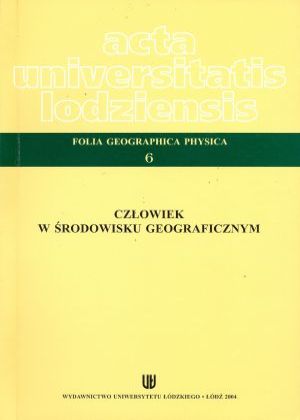
Paleośrodowiskowe zmiany w świetle analiz palinologicznych późnovistuliańskich osadów węglanowych w zagłębieniach bezodpływowych w Bełchatowie
The calcareous deposits in the upper part of Quaternary-age sediments were found in the Bełchatów mine. These deposits were accumulated in closed depressions. AIl these depressions are located in Świętojanka valley and tributary valleys (Fig. 1). The geological structure, chemical and mineral composition of calcareous deposits have been discussed elsewhere (Goździk, Konecka-BetIey 1992). In the present paper, the results of pollen analysis and more detailed field investigations of relationship between the calcareous deposits and neighbouring sediments are presented. The closed depressions were developed only the where Plenivistu1ian-age thick series of fluvial siIty-sandy sediments occur. Numerous syngenetic ice wedge casts were found in these sediments (French, Goździk 1988). Pollen analysis of organic layers included in the siIty-sandy sediments and fossil beetles from one such layer, indicate a tundra depositional environment. Similar sediments from such present-day environments are always icerich and susceptible to thermokarst processes. It is very possible that PlenivistuIian-age fluvial sediments from Bełchatów were the same. Later, when thermokarst processes had been developed, the closed depressions were formed in places with a higher ice concentration. There is other evidence which supports a supposition about the important role of thermokarst processes. The 14C dates of the beginning of the formation of the closed depressions with standing water and the period of calcareous accumulation in Świętojanka valley established by pollen analysis, are similar to analogical deposits in typical thermokarst depressions in the area of the last glaciation in northern Poland. Calcareous deposits were found always to lie on aeolian cover sands, and were never invaded by dunes. This shows that calcareous deposition began after cover formation and perhaps after dune stabilization. Organic sediments from two ancient lakes I and III (Fig. 1) were analyzed by the palynological method. Calcareous deposits and two layers of peat situated above and below them were analysed. Results of this analysis are shown on Fig. 3 for lake I and Fig. 4 for lake III. Radiocarbon dates of peats from the lower levels of organic material of two lakes are similar - 12 540± 120 BP, GD-1875 (lake I) and 12 710± 130 BP, GD-5031 (lake Ill). Results of pollen analysis of both peat layers indicate that during their accumulation the vegetational landscape had a character of a treeless tundra without traces of lacustrine plants. This vegetation was developed under subarctic climatic conditions. The pollen analysis shows that after the peat accumulation the development of the lakes and calcareous material deposition began. This deposition in lake I started during Older Dryas time. It lasted throughout Alleroo and Younger Dryas time and finished at the beginning of the Holocene. Pollen diagrams of calcareous sediments from lakes I and III show many similarities, but there are some differences. These differences may indicate colder conditions during the accumulation of calcareous material in lake I1I-:haracteristicfor Boiling period. An alternative interpretation of these differences is habitat rather than climatic. In the smaller lake III accumulation finished earlier than in lake I, that is at the and of Latevistulian.
More...

